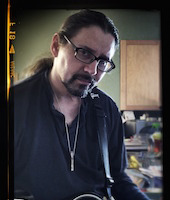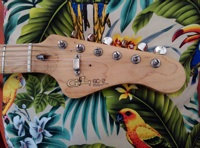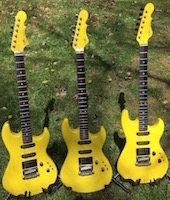Craig's post highlighting some sweet looking guitars with the "No Dots on Fingerboard" option got me thinking about my playing, in particular how much I rely on either the dots on the fret face, or the dots on the side of the neck.
I think, all things being equal, I started off using mostly the dots on the fret board face, but over the years, I've found myself using the dots on the side of the neck more often.
I've been playing for 30 years now, and while I have some proficiency, I still need to look down more often than not to know where I am. But as I considered the no dots option, I remembered teaching myself to touch type. I am a computer programmer by day, and that means a lot of typing. For the first couple of years I was a hunt-and-peck guy. I could hunt and peck quite quickly, but I never seemed able to type without looking. I tried a few typing tutors, but always found myself just looking at the keyboard when I was stuck - and that turned out to be the only real hindrance to my becoming a proficient typist. I can type 70 wpm now reliably, and faster if I need to, but 70 or so is better than twice my speed as a hunt and peck typist.
The notion of dotless frets is causing me to think very hard about leveraging what I have learned from typing to my handling of the fretboard. It is similar enough (to me) to consider it, in fact I think I have one of those gut-deep intuitions that I know this to be true, even as I don't want to admit it because it would incite me to pursue it and I am lazy and don't want to - but I thought I would comment on it and see if anyone has gone this route and found it to make a difference to their playing.
I know that sometimes I play in the dark or with my eyes closed, and I can pretty much move around - I think anyone whose been playing for long enough can do that - but once I flub a note, it's takes a few dissonant flubs for me to find my way back - which is where dots are very handy. But I wonder if forcing myself to find the right note without using my eyes wouldn't force me to increase my awareness of the fretboard in a way that relying on my eyes stifles.
I wouldn't mind hearing other opinions - and especially testimonies from anyone who has gone the way of the dotless Fretboard - or perhaps play another stringed instrument without such visual cues.
The "No Dots on Fingerboard" option...
-
DanDoulogos

- Posts: 687
- Joined: Tue Dec 20, 2016 9:08 am
- Location: Canada
The "No Dots on Fingerboard" option...
G & L: '08 Comanche (Tribute) | '14 ASAT Classic | '00 ASAT Spec | '21 JB2 (Tribute)
Other: '87 Strat | '05 Heritage CH-157 | '12 Tele Select Koa | '19 MJT Esquire | '18 Taylor | 2015 Chrome Epi Dobro |
Other: '87 Strat | '05 Heritage CH-157 | '12 Tele Select Koa | '19 MJT Esquire | '18 Taylor | 2015 Chrome Epi Dobro |
-
Al Evans
- Posts: 40
- Joined: Fri Mar 25, 2016 2:01 pm
Re: The "No Dots on Fingerboard" option...
My main acoustic (Kinscherff High Noon) doesn't have front dots. My grandson is a classical guitarist, and of course, has no dots on his guitar. I play other things (fretted and fretless basses, piano) as well as guitar, and looking for positions on piano, especially, is a losing proposition. You've got to know where you are. So I practice with my eyes closed, or just force myself not to look. I've found it useful on guitar to practice interval shifts, up and down a minor third, major third, fourth, fifth, etc. from different positions on all the strings.DanDoulogos wrote:
I wouldn't mind hearing other opinions - and especially testimonies from anyone who has gone the way of the dotless Fretboard - or perhaps play another stringed instrument without such visual cues.
Studies have been done in the context of violin (where it's ergonomically not so good to be looking at the fingerboard) and have found that once the player learns not to look, accuracy is just as good as when they look.
So that's my opinion.
--Al Evans
-
DanDoulogos

- Posts: 687
- Joined: Tue Dec 20, 2016 9:08 am
- Location: Canada
Re: The "No Dots on Fingerboard" option...
Thanks Al. I think I'm going to begin a no-looksies policy when I practice from now on.
I learned a lesson from cursive writing. My handwriting was pretty typical, in that it was ugly and barely legible. I stuck to printing for most of my life. But a few years ago I recalled reading my grandfather's notes from WWI - and though he wasn't even twenty at the time, his penmanship looked like calligraphy to me. I decided in retrospect, to be intentional in my penmanship, and forced myself to write in cursive exclusively, and to write with as much beauty as I was able. In a very short white I discovered that most of my script was messy because I was sizing my letters inconsistently, so I intentionally forced myself to slow down and take care to make my letters uniform in size. Next I noticed that my slant was all over the place, so I forced myself to write each letter with the same intentional slant. My upper case letters were ugly, so I began to seek out better examples of handwritten Capital letters that what I had been doing, and again, intentionally forced myself to start using better versions of the same letters I had always written.
Today, though my handwriting is not as good as my memory of my grandfather's hand, yet it is very clean, and even elegant. As a pastor, I find writing personal letters (rather than typing them) conveys my genuine concerns with greater intimacy. There is just something about knowing the person who wrote you this, sat down and wrote it. People appreciate it.
Well, what I've learned from writing is that my writing sucked forever until I was very intentional about fixing that. I am always looking for ways to improve my penmanship, but my success in that venture is training me to be more intentional in the pursuit of excellence elsewhere - such as in my playing. I think what you said rings true in my ear, and I thank you for adding that, as it reinforces my already settling opinion that this is something I should do.
I learned a lesson from cursive writing. My handwriting was pretty typical, in that it was ugly and barely legible. I stuck to printing for most of my life. But a few years ago I recalled reading my grandfather's notes from WWI - and though he wasn't even twenty at the time, his penmanship looked like calligraphy to me. I decided in retrospect, to be intentional in my penmanship, and forced myself to write in cursive exclusively, and to write with as much beauty as I was able. In a very short white I discovered that most of my script was messy because I was sizing my letters inconsistently, so I intentionally forced myself to slow down and take care to make my letters uniform in size. Next I noticed that my slant was all over the place, so I forced myself to write each letter with the same intentional slant. My upper case letters were ugly, so I began to seek out better examples of handwritten Capital letters that what I had been doing, and again, intentionally forced myself to start using better versions of the same letters I had always written.
Today, though my handwriting is not as good as my memory of my grandfather's hand, yet it is very clean, and even elegant. As a pastor, I find writing personal letters (rather than typing them) conveys my genuine concerns with greater intimacy. There is just something about knowing the person who wrote you this, sat down and wrote it. People appreciate it.
Well, what I've learned from writing is that my writing sucked forever until I was very intentional about fixing that. I am always looking for ways to improve my penmanship, but my success in that venture is training me to be more intentional in the pursuit of excellence elsewhere - such as in my playing. I think what you said rings true in my ear, and I thank you for adding that, as it reinforces my already settling opinion that this is something I should do.
G & L: '08 Comanche (Tribute) | '14 ASAT Classic | '00 ASAT Spec | '21 JB2 (Tribute)
Other: '87 Strat | '05 Heritage CH-157 | '12 Tele Select Koa | '19 MJT Esquire | '18 Taylor | 2015 Chrome Epi Dobro |
Other: '87 Strat | '05 Heritage CH-157 | '12 Tele Select Koa | '19 MJT Esquire | '18 Taylor | 2015 Chrome Epi Dobro |
-
blargfromouterspace

- Posts: 2390
- Joined: Sat Apr 03, 2010 5:45 am
- Location: Central Highlands, Australia
Re: The "No Dots on Fingerboard" option...
Your typing analogy is spot on, they make a nice reference if you forget where you are. I've found I get by just fine with the side dots until I look down and don't see them, get confused and then come the brown notes. I went with no dots on a guitar because I thought it might look better, but it just looks more 'metal'.
-Jamie
-
FZTNT

- Posts: 973
- Joined: Tue Jan 19, 2016 3:27 pm
- Location: DC Area, Virginia
Re: The "No Dots on Fingerboard" option...
Dan, what you need is Sister Lucy, the "should have retired well before I was in her class at Catholic school in the UK" nun. No kidding, carried the big eighteen inch ruler and everything. I never did learn to write well but my knuckles can break bricks.
Tom
Tom
-
DanDoulogos

- Posts: 687
- Joined: Tue Dec 20, 2016 9:08 am
- Location: Canada
Re: The "No Dots on Fingerboard" option...
@Tom - that made me smile.
G & L: '08 Comanche (Tribute) | '14 ASAT Classic | '00 ASAT Spec | '21 JB2 (Tribute)
Other: '87 Strat | '05 Heritage CH-157 | '12 Tele Select Koa | '19 MJT Esquire | '18 Taylor | 2015 Chrome Epi Dobro |
Other: '87 Strat | '05 Heritage CH-157 | '12 Tele Select Koa | '19 MJT Esquire | '18 Taylor | 2015 Chrome Epi Dobro |
-
Lacking Talent

- Posts: 186
- Joined: Sat Feb 16, 2013 7:29 pm
- Location: Los Angeles, CA
Re: The "No Dots on Fingerboard" option...
A well-styled guitar can look great without dots, of course, but I've got to have them (at least on the side of the neck).